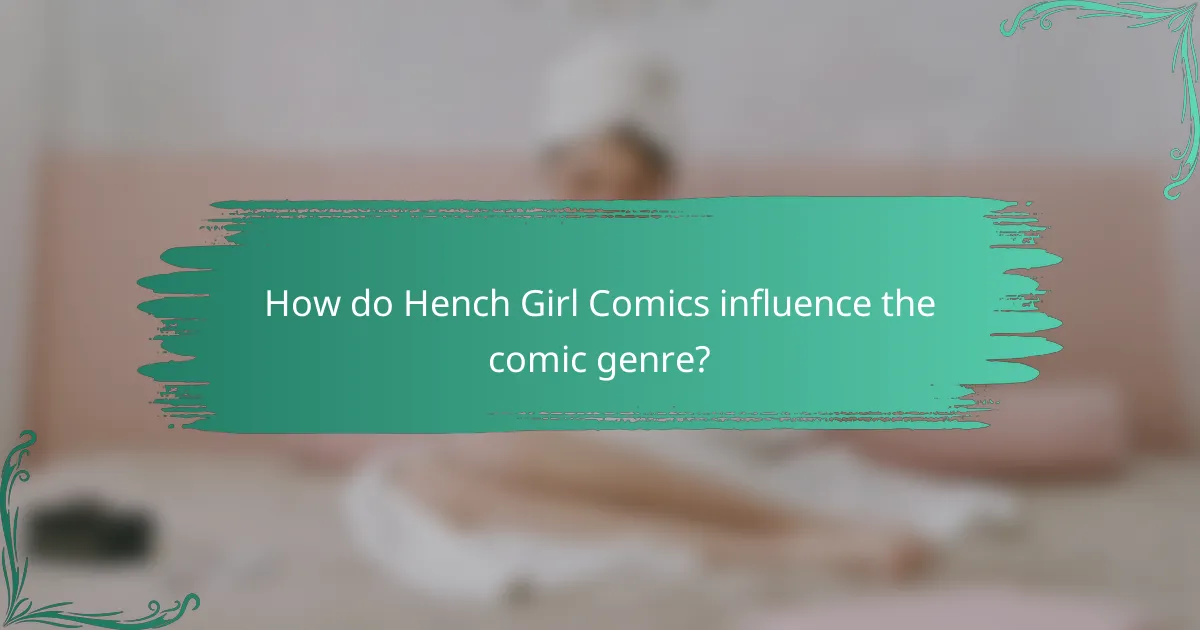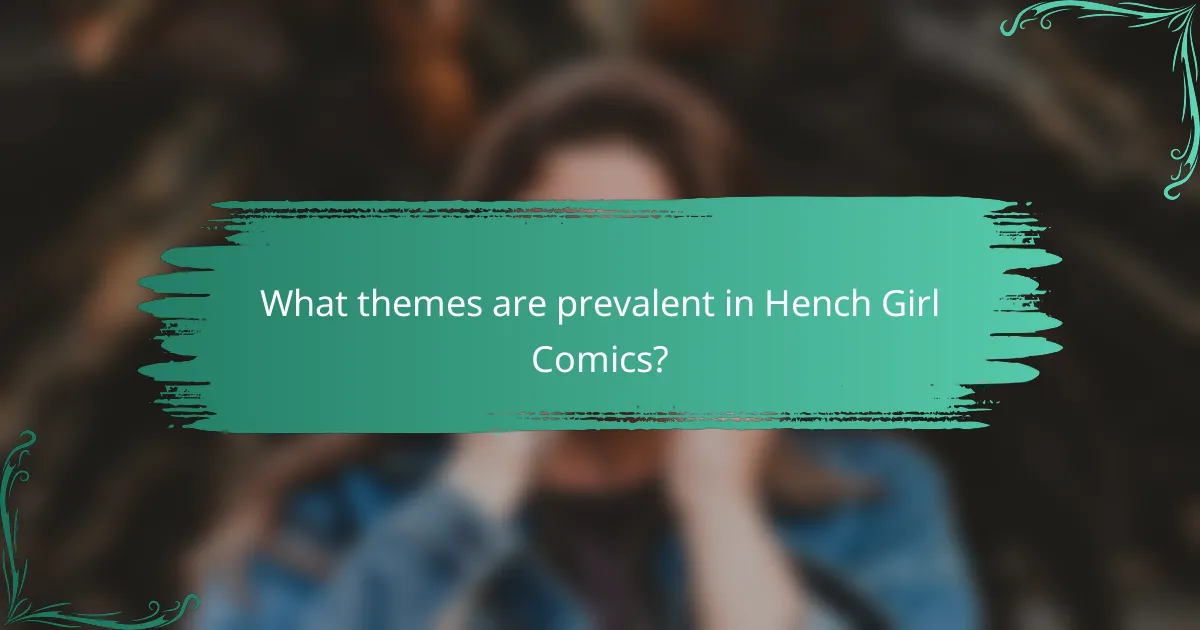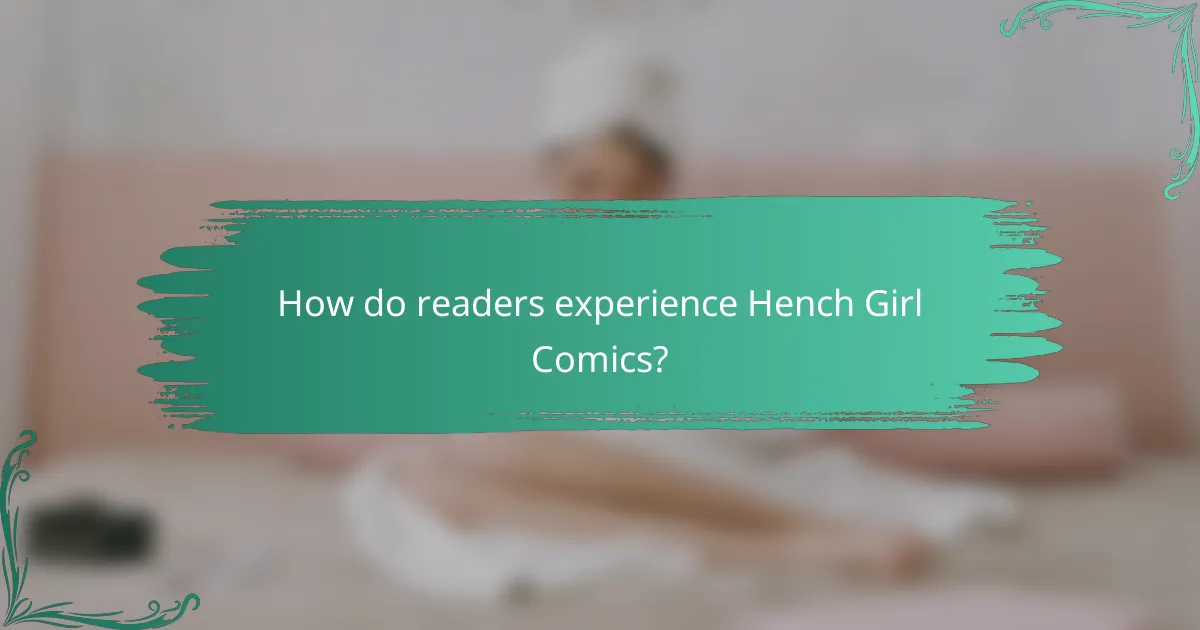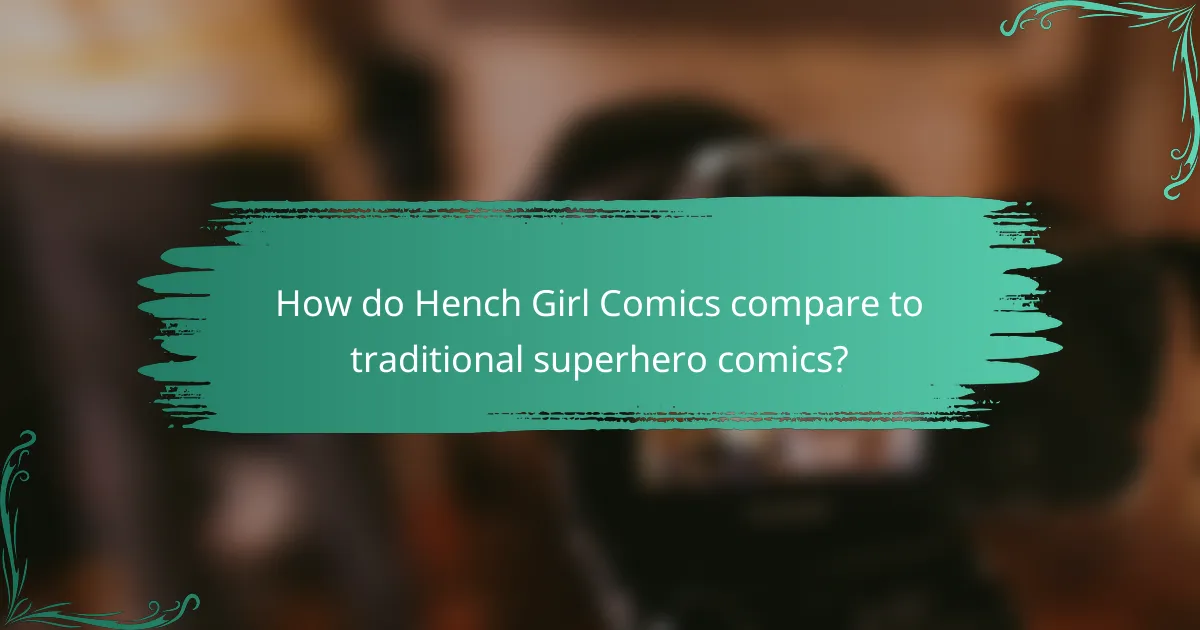Hench girl comics play a pivotal role in redefining the comic genre by offering fresh narratives that subvert conventional roles and tropes. By intertwining humor, action, and social commentary, they not only expand thematic possibilities but also foster deeper emotional connections with readers through relatable characters and engaging storylines.

How do Hench Girl Comics influence the comic genre?
Hench girl comics significantly influence the comic genre by introducing unique narratives that challenge traditional roles and tropes. They often blend humor, action, and social commentary, reshaping reader expectations and expanding the thematic scope of comics.
Impact on superhero narratives
Hench girl comics often subvert typical superhero narratives by focusing on the sidekicks or henchmen rather than the main heroes. This shift allows for a more nuanced exploration of morality, loyalty, and the complexities of villainy, enriching the overall storytelling landscape.
For example, these comics can portray hench girls as multi-dimensional characters who grapple with their choices, providing a fresh perspective on the classic good versus evil dichotomy. This approach encourages readers to question the motivations behind their favorite heroes and villains.
Integration of feminist themes
Hench girl comics frequently incorporate feminist themes, highlighting issues such as empowerment, identity, and gender roles. By centering female characters who are often marginalized in traditional narratives, these comics promote discussions about equality and representation in the genre.
These stories often showcase female characters who defy stereotypes, demonstrating strength and agency while navigating a male-dominated world. This representation resonates with readers and inspires a broader dialogue about women’s roles in both comics and society.
Character development trends
Character development in hench girl comics tends to focus on personal growth and transformation, often depicting the journey from villainy to heroism or self-acceptance. This trend allows for rich character arcs that engage readers on an emotional level.
For instance, a hench girl might start as a loyal sidekick but evolve into a leader or a hero in her own right, showcasing resilience and adaptability. Such narratives encourage readers to empathize with characters who might otherwise be seen as mere antagonists.
Visual style evolution
The visual style of hench girl comics has evolved to reflect contemporary artistic trends, often featuring vibrant colors and dynamic layouts that enhance storytelling. This evolution not only attracts a diverse audience but also sets new standards for visual storytelling in the genre.
Artists often experiment with styles that blend traditional comic art with modern influences, creating a unique aesthetic that stands out. This innovation can make hench girl comics visually appealing and accessible to a wider range of readers.
Influence on mainstream media
Hench girl comics have begun to influence mainstream media, inspiring adaptations in television and film. Their unique narratives and strong female characters resonate with audiences, leading to increased demand for similar content across various platforms.
As a result, we see more shows and movies that feature complex female characters in roles traditionally reserved for male heroes. This shift not only reflects changing societal attitudes but also opens doors for new storytelling possibilities in the entertainment industry.

What themes are prevalent in Hench Girl Comics?
Hench girl comics often explore themes such as empowerment, friendship, conflict, and identity. These themes resonate with readers by showcasing the complexities of character development and the emotional journeys of the protagonists.
Empowerment and agency
Empowerment and agency are central themes in hench girl comics, portraying characters who take control of their destinies. These narratives often depict female characters who challenge traditional roles, asserting their strength and independence in a male-dominated world.
For instance, protagonists may start as sidekicks but evolve into leaders, making choices that reflect their desires and values. This transformation emphasizes the importance of self-determination and personal growth.
Friendship and loyalty
Friendship and loyalty play significant roles in hench girl comics, highlighting the bonds formed between characters. These relationships often serve as a source of strength, providing emotional support during challenging times.
Characters frequently navigate conflicts together, showcasing how loyalty can lead to personal sacrifices and growth. The dynamics of these friendships often reveal deeper themes of trust and resilience.
Conflict and resolution
Conflict and resolution are key elements that drive the plot in hench girl comics. Characters face various challenges, whether external threats from villains or internal struggles with their identities. These conflicts create tension and propel character development.
Resolution often comes through collaboration or self-reflection, emphasizing the importance of teamwork and personal insight. Readers witness how overcoming obstacles can lead to stronger relationships and a clearer sense of purpose.
Identity and self-discovery
Identity and self-discovery are prevalent themes, as characters often grapple with their roles in society and their personal beliefs. Hench girl comics provide a platform for exploring what it means to be true to oneself amidst societal expectations.
Through their journeys, characters may confront their pasts, question their loyalties, and ultimately embrace their unique identities. This theme resonates with readers, encouraging them to reflect on their own paths of self-discovery.

How do readers experience Hench Girl Comics?
Readers experience Hench Girl Comics through a blend of engaging narratives, relatable characters, and community involvement. This genre often resonates with audiences by presenting unique perspectives on traditional superhero themes, allowing for deeper emotional connections and discussions.
Reader demographics and engagement
The demographics of Hench Girl Comics readers vary widely, often including young adults and women who seek representation in the comic book world. Engagement levels are typically high, as readers frequently participate in discussions on social media platforms and attend conventions to connect with creators and fellow fans.
Many readers appreciate the genre’s ability to challenge stereotypes and provide fresh takes on heroism, which can lead to a dedicated fan base. This engagement is often reflected in the popularity of related merchandise and fan art.
Emotional responses to characters
Readers often develop strong emotional responses to characters in Hench Girl Comics, particularly those who embody resilience and complexity. Characters that struggle with their identities or moral dilemmas resonate deeply, allowing readers to reflect on their own experiences.
For example, a character who transitions from a sidekick to a hero can evoke feelings of empowerment and inspiration, making the narrative more impactful. This emotional connection can enhance the overall reading experience, encouraging readers to invest in the story and its characters.
Community and fan culture
The community surrounding Hench Girl Comics is vibrant and supportive, often fostering a culture of inclusivity. Fans frequently share their interpretations and artwork, creating a sense of belonging among readers who appreciate the genre’s themes.
Online forums and social media groups serve as platforms for discussion, where fans can analyze story arcs, share fan theories, and celebrate character development. This active participation not only enhances the reading experience but also strengthens the community’s bond, making it a vital aspect of the Hench Girl Comics phenomenon.

What are the key criteria for analyzing Hench Girl Comics?
Key criteria for analyzing Hench Girl Comics include character arcs, artistic style, and thematic development. These elements significantly influence the reader’s experience and understanding of the narrative.
Character arcs and development
Character arcs in Hench Girl Comics often focus on the evolution of the protagonist, typically a hench girl navigating her role within a villainous framework. Readers should pay attention to how these characters transform, facing moral dilemmas and personal growth throughout the story.
Common pitfalls include overlooking secondary characters who may also undergo significant development. Supporting characters can provide essential context and contrast, enriching the main character’s journey. Analyzing their arcs can reveal deeper themes of loyalty, ambition, and identity.
Artistic style and presentation
The artistic style in Hench Girl Comics plays a crucial role in conveying mood and tone. The use of color palettes, line work, and panel layouts can enhance the storytelling, making it essential to consider how these elements reflect the narrative’s themes. For instance, darker color schemes may underscore themes of conflict or moral ambiguity.
When evaluating presentation, look for consistency and innovation in the artwork. A well-executed style can elevate the reader’s engagement and emotional response. Consider how the visual elements interact with the text, as this synergy is vital for a cohesive reading experience.

How do Hench Girl Comics compare to traditional superhero comics?
Hench girl comics often present a fresh perspective compared to traditional superhero comics by focusing on the lives and experiences of side characters, particularly female villains or henchwomen. This genre emphasizes themes of empowerment, identity, and moral ambiguity, offering readers a nuanced take on the superhero narrative.
Genre Influence
The genre of hench girl comics draws inspiration from traditional superhero comics while subverting many of their conventions. Unlike classic superhero tales that typically center on the hero’s journey, hench girl comics explore the complexities of villainy and the often-overlooked roles of female characters. This shift allows for a broader range of storytelling that includes humor, drama, and social commentary.
For example, while traditional superhero comics may glorify heroism, hench girl comics often highlight the struggles and motivations of those who work for the villains, providing a more relatable and humanized perspective. This approach can resonate with readers seeking depth and character development beyond the typical good-versus-evil dichotomy.
Thematic Development
Thematic development in hench girl comics frequently revolves around empowerment, identity, and the questioning of moral values. These comics often challenge stereotypes by portraying female characters as complex individuals with their own ambitions and struggles, rather than mere sidekicks or love interests. This thematic focus allows for rich narratives that explore issues such as loyalty, ambition, and the consequences of one’s choices.
Additionally, hench girl comics may incorporate themes of friendship and betrayal, showcasing how relationships evolve in the context of villainy. This adds layers to the storytelling, making it relatable to readers who appreciate character-driven plots.
Reader Experience
The reader experience in hench girl comics is often characterized by a blend of humor and introspection, inviting audiences to connect with characters on a personal level. Readers may find themselves empathizing with the struggles of hench girls as they navigate their roles in a world dominated by heroes and villains. This emotional engagement can enhance the overall enjoyment of the narrative.
Moreover, the unique perspective offered by hench girl comics can lead to a more inclusive reading experience, appealing to those who may feel marginalized in traditional superhero narratives. By presenting stories that reflect diverse experiences and viewpoints, these comics foster a sense of community among readers who appreciate varied representations in the genre.
